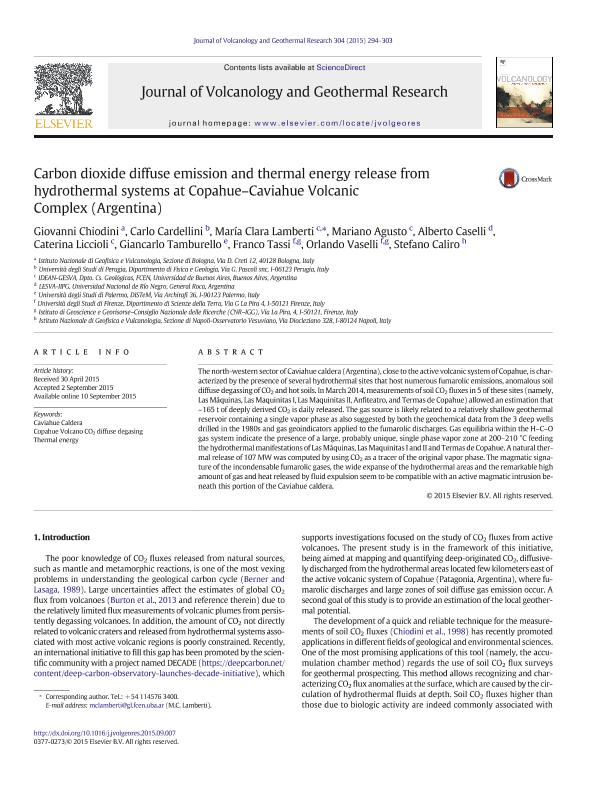Artículo
Carbon dioxide diffuse emission and thermal energy release from hydrothermal systems at Copahue-Caviahue Volcanic Complex (Argentina)
Chiodini, Giovanni; Cardellini, Carlo; Lamberti, María Clara Isabel ; Agusto, Mariano Roberto
; Agusto, Mariano Roberto ; Caselli, Alberto Tomás
; Caselli, Alberto Tomás ; Liccioli, Caterina
; Liccioli, Caterina ; Tamburello, Giancarlo; Tassi, Franco; Vaselli, Orlando; Caliro, Stefano
; Tamburello, Giancarlo; Tassi, Franco; Vaselli, Orlando; Caliro, Stefano
 ; Agusto, Mariano Roberto
; Agusto, Mariano Roberto ; Caselli, Alberto Tomás
; Caselli, Alberto Tomás ; Liccioli, Caterina
; Liccioli, Caterina ; Tamburello, Giancarlo; Tassi, Franco; Vaselli, Orlando; Caliro, Stefano
; Tamburello, Giancarlo; Tassi, Franco; Vaselli, Orlando; Caliro, Stefano
Fecha de publicación:
09/2015
Editorial:
Elsevier Science
Revista:
Journal of Volcanology and Geothermal Research
ISSN:
0377-0273
Idioma:
Inglés
Tipo de recurso:
Artículo publicado
Clasificación temática:
Resumen
The north-western sector of Caviahue caldera (Argentina), close to the active volcanic systemof Copahue, is characterizedby the presence of several hydrothermal sites that host numerous fumarolic emissions, anomalous soildiffuse degassing of CO2 and hot soils. In March 2014,measurements of soil CO2 fluxes in 5 of these sites (namely,LasMáquinas, Las Maquinitas I, Las Maquinitas II, Anfiteatro, and Termas de Copahue) allowed an estimation that~165 t of deeply derived CO2 is daily released. The gas source is likely related to a relatively shallow geothermalreservoir containing a single vapor phase as also suggested by both the geochemical data from the 3 deep wellsdrilled in the 1980s and gas geoindicators applied to the fumarolic discharges. Gas equilibria within the H?C?Ogas system indicate the presence of a large, probably unique, single phase vapor zone at 200?210 °C feedingthe hydrothermalmanifestations of LasMáquinas, LasMaquinitas I and II and Termas de Copahue. A natural thermalrelease of 107 MWwas computed by using CO2 as a tracer of the original vapor phase. The magmatic signatureof the incondensable fumarolic gases, the wide expanse of the hydrothermal areas and the remarkable highamount of gas and heat released by fluid expulsion seemto be compatiblewith an active magmatic intrusion beneaththis portion of the Caviahue caldera.
Palabras clave:
CAVIAHUE CALDERA
,
COPAHUE VOLCANO
,
CO2 DIFFUSE
,
THERMAL ENERGY
Archivos asociados
Licencia
Identificadores
Colecciones
Articulos(IDEAN)
Articulos de INSTITUTO DE ESTUDIOS ANDINOS "DON PABLO GROEBER"
Articulos de INSTITUTO DE ESTUDIOS ANDINOS "DON PABLO GROEBER"
Citación
Chiodini, Giovanni; Cardellini, Carlo; Lamberti, María Clara Isabel; Agusto, Mariano Roberto; Caselli, Alberto Tomás; et al.; Carbon dioxide diffuse emission and thermal energy release from hydrothermal systems at Copahue-Caviahue Volcanic Complex (Argentina); Elsevier Science; Journal of Volcanology and Geothermal Research; 304; 9-2015; 294-303
Compartir
Altmétricas



